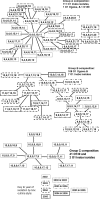Relatedness of Vibrio cholerae O1/O139 isolates from patients and their household contacts, determined by multilocus variable-number tandem-repeat analysis
- PMID: 20585059
- PMCID: PMC2937383
- DOI: 10.1128/JB.00698-10
Relatedness of Vibrio cholerae O1/O139 isolates from patients and their household contacts, determined by multilocus variable-number tandem-repeat analysis
Abstract
The genetic relatedness of Vibrio cholerae O1/O139 isolates obtained from 100 patients and 146 of their household contacts in Dhaka, Bangladesh, between 2002 and 2005 was assessed by multilocus variable-number tandem-repeat analysis. Isolate genotypes were analyzed at five loci containing tandem repeats. Across the population, as well as within households, isolates with identical genotypes were clustered in time. Isolates from individuals within the same household were more likely to have similar or identical genotypes than were isolates from different households, but even within a household, isolates from different individuals often had different genotypes. When household contacts were sampled regularly for 3 weeks after the illness of the household index patient, isolates with genotypes related to the index patient appeared in contacts, on average, approximately 3 days after the index patient, while isolates with unrelated genotypes appeared in contacts approximately 6 days after. Limited data revealed that multiple isolates from the same individual collected within days of each other or even from a single stool sample may have identical, similar, or unrelated genotypes as well. Our results demonstrate that genetically related V. cholerae strains cluster in local outbreaks but also suggest that multiple distinct strains of V. cholerae O1 may circulate simultaneously within a household.
Figures




References
-
- Albert, M. J., M. Ansaruzzaman, P. K. Bardhan, A. S. G. Faruque, S. M. Faruque, M. S. Islam, D. Mahalanabis, R. B. Sack, M. A. Salam, A. K. Siddique, M. D. Yunus, and K. Zaman. 1993. Large epidemic of cholera-like disease in Bangladesh caused by Vibrio cholerae O139 synonym Bengal. Lancet 342:387-390. - PubMed
-
- Bakhshi, B., H. M. Barzelighi, M. Adabi, A. R. Lari, and M. R. Pourshafie. 2009. A molecular survey on virulence associated genotypes of non-O1 non-O139 Vibrio cholerae in aquatic environment of Tehran, Iran. Water Res. 43:1441-1447. - PubMed
Publication types
MeSH terms
Substances
Grants and funding
LinkOut - more resources
Full Text Sources

